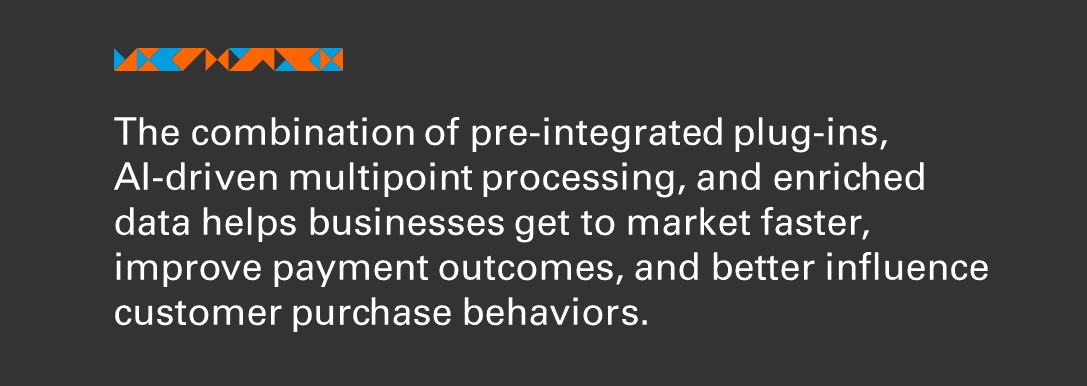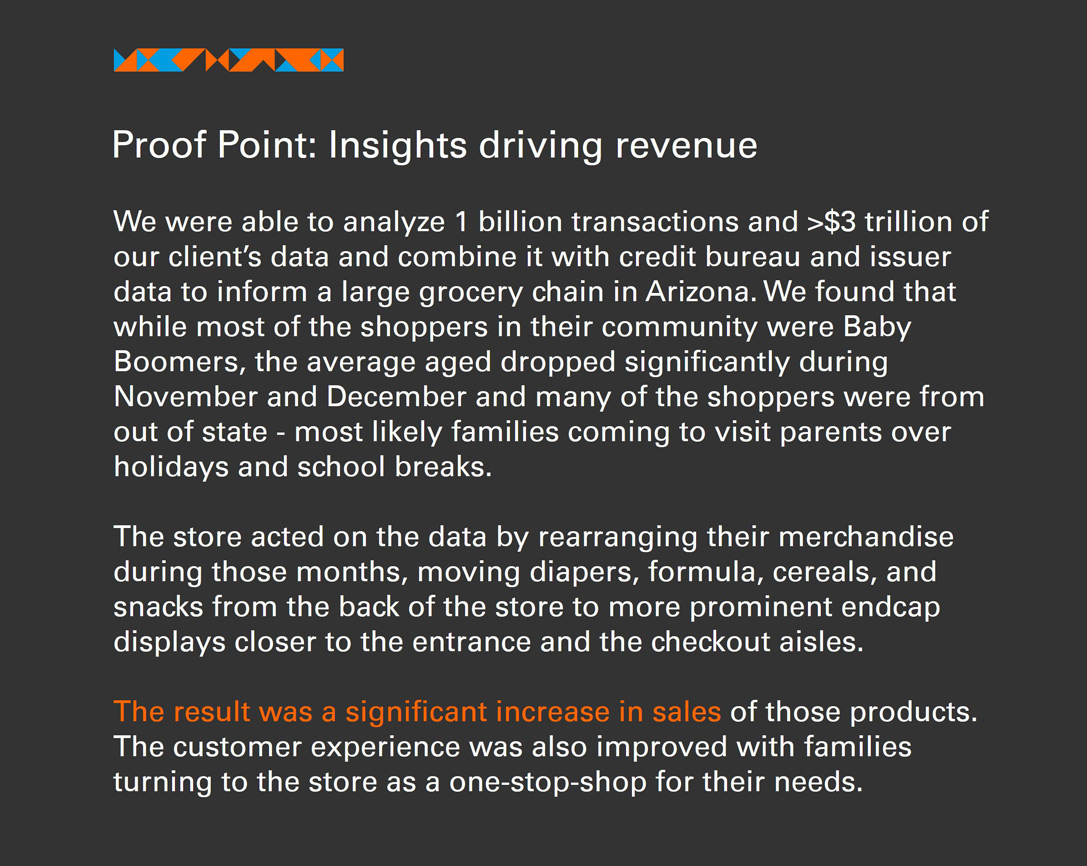
Accepting payments has become increasingly complex as consumers move across physical, digital, and mobile channels to find, purchase, pick-up and return items. Organizations must be able to mobilize and innovate faster, whether prompted by external influences and trends or pressures from traditional and upstart competitors.
Consolidating backend and customer-facing systems allows your tech teams to refocus developers on strategic revenue initiatives. For even faster innovation, connection to a single platform with multiple pre-certified value-add solutions and processing endpoints saves time, resources, and money. Additionally, the ability to leverage AI-enriched anonymized data from transaction processors, card issuers, credit bureaus, banks and technology partners enables businesses to gain a deeper understanding of their customers.

#1 - Speed time to market and boost productivity
Traditionally, IT departments have “bolted on” services from multiple vendors natively, creating an inefficient, costly, and cumbersome web of systems and interfaces to manage payments across an enterprise. Multiple development, testing and release cycles limit an organization’s ability to gain a holistic view of their business and their customers.
Recent advances in technology and machine learning (AI) allow organizations to save time and money by consolidating separate systems, implementation cycles, and onboarding across channels via one simple and smart interface to an integrated omnichannel commerce hub. Since multiple platform, processor and VAS integrations are already built in, the time to code, test, validate connectivity, and certify is eliminated.
Pre-integrated shopping carts allow you to get eCommerce sites up and running quickly in multiple global markets, eliminating the need to build, manage and enhance proprietary checkout software.
Out-of-the-box plug-ins to enterprise systems—POS, ERP, EMR, OMS, CRM—from leading vendors allow you to consume and share secure tokenized transaction data easily across all channels and systems for decisioning, AR/AP system reconciliation, merchandising, invoice management, customer analytics and more.
Pre-certified connectivity to a choice of payment processors and acquirers eliminates the need for IT developers to build and maintain multiple integrations across channels, regions, and brands. You gain a consolidated view of all transactions regardless of the processing endpoint, eliminating the need to login to multiple portals to manage activity.
Tokenization is the secret sauce to unlock business potential and optimize omnichannel customer experiences. Tokens can efficiently and securely share data across brands, locations, departments, channels, systems and platforms without exposing sensitive card details. They facilitate everything from a simple sale to pre-authorizations, multi-capture/multi-ship purchases, recurring/subscription payments, invoice adjustments, and returns processing. Tokenization also simplifies returns and fights fraud by allowing systems from across an enterprise—POS, eCommerce, ordering—to issue returns to the card used for the original purchase without requiring the customer to present the card or expose card details.
#2 – Improve payment outcomes
One key to delivering optimized omnichannel shopping experiences and improving customer loyalty is to make it easy to make a purchase. Cart abandonment is one thing. Declining sales due to expired cards, technical limitations or false positives limits revenue and may result in lost customers for the long haul. Combining advanced processing capabilities with machine learning and data from card brands and issuing banks helps enable more meaningful and consistent experiences across the commerce journey, removes potential speedbumps that could result in abandoned sales, and ultimately results in increased authorizations.
Get higher authorization rates and improve cashflow by using a Card Account Updater to ensure cards on file, and related multi-use tokens, remain accurate when credentials such as card numbers, expiry dates and status change. This allows for recurring and future transactions to run smoothly without requiring customer outreach. Proactively managing cards-on-file in real time—vs. batch updates with individual card brands—reduces the possibility of service cancellations.
Recognize and authorize more transactions with adaptive authorization technology that combines a card issuer’s logic with machine-learning rules-based engine. This allows the issuer’s system to adjust transaction indicators in compliance with payment industry standards, maximizing approval rates.
A processing platform featuring intelligent transaction optimization drives value in ways beyond an increase in approvals and revenue lift. You can save on processing costs when data science is applied to routing logic based on cards, issuers, and channels.
Lower the cost of debit acceptance by up to 45 bps with dynamic debit routing that eliminates card brand interchange fees. Transactions can be processed across all commerce channels via connectivity to a nationwide network of debit platform providers such as STAR, Accel, Pulse and NYCE. Dynamic routing algorithms determine the optimal processing end point depending on the network, transaction costs, approval rates and other algorithm-driven factors.
BIN-logic routing uses machine-based learning and multi-point processing to direct transactions to a processor or acquirer based on card issuer, channel, or retailer-defined preferences. An AI-driven algorithm can detect which bank issued the consumer’s card and route it to the same bank for processing, typically resulting in a lower rate than that of the merchant’s primary processor. When transactions are funneled through one single interface hub, tokenized, and consolidated for reporting, management and analytics, businesses save time and money managing payments activity.
The shift to digital means a higher percentage of payments are being accepted via online channels, which carry an increased risk of fraud. This translates to higher interchange costs as well as an increase in chargebacks and write-offs. Approving legitimate purchases and optimizing returns will improve the omnichannel shopping experience and encourage repeat business.
Online shoppers have adopted a “buy, try, return” mentality that further raises costs and eats into profits. Identifying serial returners can help you develop models to mitigate the behavior and keep more revenue.
Help detect fraud and prevent losses with Customized AI-driven fraud models, behavioral analytics and link analysis that score every transaction in real time . The ability to isolate and learn based on specific merchant data models and tolerance levels—combined with knowledge of fraud trends at a global scale—reduces both false negatives and false positives, resulting in better decisioning and a better customer experience.
Reduce overall return rates by using enriched data from historical trends, transaction processing, and issuing partners to connect cards with individuals and identify serial returners while they are in the process of making a purchase. This gives you an opportunity to present select customers with an incentive such as “20% off now if sale is final”.
#3 - Influence customer purchasing behaviors
We have entered the “always on” era of connected customers, experiences, and commerce. Consumers demand more personalized experiences aligned with their preferences in how they interact, engage, make purchase decisions, and pay. Bringing systems and data together allows retailers to identify and interact with each customer in one voice.
Harnessing enriched data connects cards, individuals, and households to a series of primary account numbers (PAN) that create a unique ID using anonymized consumer data. This allows you to invest in rich marketing capabilities to better predict behavior. Credit bureau details further help identify locations, family demographics and credit scores. Omnichannel processors provide insights from across a vast ecosystem of businesses to reveal where consumers shop (types of businesses, brands, locations, zip codes, etc.), how consumers shop (in person, online, in app, etc.), what their payment preferences are, and how much they spend.

Learn more about how you can simplify your omnichannel integration or contact a Carat expert today.




